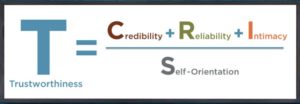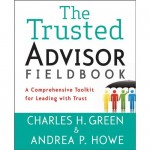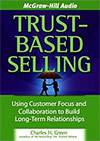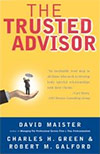Trust relationships are vital to the conduct of business. Some base level of trust is required just to have employment contracts, or to engage in commercial transactions. Beyond such minimum thresholds, trust also plays a major role.
The level of trust in business relationships—whether external, e.g. in sales or advisory roles, or internal, e.g. in a services function—is a greater determinant of success than anything else, including content excellence.

How can we think about trust? What conceptual frameworks do we need in order to intelligently assess and improve on trust relationships, and in particular on our levels of trustworthiness?
This article lays out the core trust models I have developed and adopted over the years. They are taken from The Trusted Advisor (with Maister and Galford, Free Press, 2000), and Trust-based Selling (McGraw-Hill, 2006). There are three.
- The Trust Equation: a deconstructive, analytical model of the components of trustworthiness;
- The Trust Creation Process: a process model of trust creation through personal interaction—mainly conversations;
- The Trust Principles: four principles, or values, which serve as guides to decision-making and conduct to increase trust.
The Trust Equation
Trust is a bi-lateral relationship—one trusts, and the other is the trusted. While the two are related, they’re not the same thing. The trust equation is a model for the second—the one who would be trusted. It is about trustworthiness.
Often we intend more than one thing when we use the word trust. We use it to describe what we think of what people say. We also use it to describe behaviors. We use it to describe whether or not we feel comfortable sharing certain information with someone else. And we use the same word to indicate whether or not we feel other people have our interests at heart, vs. their own interests.
Those four variables can be described as Credibility, Reliability, Intimacy, and Self-Orientation. They can be combined in an equation.
The Trust Equation

Credibility has to do with the words we speak. In a sentence, we might say, “I can trust what she says about intellectual property; she is very credible on the subject.
By contrast, reliability has to do with actions. We might say, for example, “If he says he’ll deliver the product tomorrow, I trust him, because he’s dependable.”
Intimacy refers to the safety or security that we feel when entrusting someone with something. We might say, “I can trust her with that information; she’s never violated my confidentiality before, and she would never embarrass me.”
Self-orientation refers to the focus of the person in question. In particular, whether the person’s focus is primarily on himself or herself or on the other person. We might say, “I can’t trust him on this deal—I don’t think he cares enough about me, he’s focused on what he gets out of the deal.” Or—more commonly—“I don’t trust him—I think he was too concerned about how he was appearing, so he wasn’t really paying attention.”
Increasing the value of the factors in the numerator increases the value of trust. Increasing the value of the denominator—that is, self-orientation—decreases the value of trust.
Since there is only one variable in the denominator and three in the numerator, the most important factor is self-orientation. This is intentional. A seller with low self-orientation is free to really, truly, honestly focus on the customer. Not for his own sake, but for the sake of the customer. Such a focus is rare among salespeople (or people in general, for that matter).
Looking at trust this way covers most of the common meanings of trust that we encounter in everyday business interactions. Note that the meanings are almost entirely personal, not institutional.
People don’t primarily trust institutional entities, they trust other people. The components of credibility and reliability are sometimes used to describe companies or Websites, but at least as often to describe people. The other components—intimacy and self-orientation—are almost entirely about people.
Trust in selling requires good “scores” on all four variables in the equation. But the most important, by far, is low levels of self-orientation.
Living the four trust values is the best way to increase your trustworthiness.
The Trust Creation Process
Trust typically gets created at the individual level, between people, and usually in conversations. The Trust Creation Process is a five-step model for that process:

- Engage the client in an open discussion about issues that are key to the client;
- Listen to what is important and real to the client; earn the right to offer solutions;
- Frame the true root issue, without the language of blame, via caveats, problem statements and hypotheses; take personal risks to explore sensitive issues—articulate a point of view; create by giving away;
- Envision an alternate reality, including win-win specific descriptions of outcomes and results, including emotional and political states; clarify benefits—make clear what’s at stake; be tangible about future states;
- Commit to actionable next steps that imply significant commitment and movement on the part of each party.
The order in which these sentences occur in a conversation has as much impact as the sentences themselves. That is, you could do a wonderful job on framing the issue or on the commitment to action—but if you do them before you do listening, then the trust process breaks down, or freezes. This becomes clearer when we translate the trust creation process into a sales context, as follows:
- Engage: I hear X may be an issue for you—is that right?
- Listen: Gee, that’s interesting; tell me more; what’s behind that?
- Frame: It sounds like what you may have here is a case of Q.
- Envision: How will things look three years from now if we fix this?
- Commit: What if we were to do Z?
The most powerful step in the Trust Creation Process by far is the Listening step. The two most common errors in practice are:
- Inadequate listening, and
- Jumping too quickly to the final, action, step.
The Trust Principles
Being or becoming trustworthy cannot be reduced to pure behaviors. You can’t bottle it in a competency model. Our actions are driven by our beliefs, and our beliefs are driven by our values or principles. Trustworthy behavior is way too complex to fake without the beliefs and values behind them. If your values don’t drive you to behave in a trustworthy manner all the time, you’ll be found out quickly.
Hence, the Trust Equation and the way we use the Trust Creation Process model are really just outcomes of the principles we hold. The way to become trusted is to act consistently from those principles—and not just any set of principles will do. There are four specific principles governing trustworthy behavior:
- A focus on the Other (client, customer, internal co-worker, boss, partner, subordinate) for the Other’s sake, not just as a means to one’s own ends.We often hear “client-focus,” or “customer-centric.” But these are terms all-too-often framed in terms of economic benefit to the person trying to be trusted.
- A collaborative approach to relationships.Collaboration here means a willingness to work together, creating both joint goals and joint approaches to getting there.
- A medium to long term relationship perspective, not a short-term transactional focus.Focus on relationships nurtures transactions; but focus on transactions chokes off relationships. The most profitable relationships for both parties are those where multiple transactions over time are assumed in the approach to each transaction.
- A habit of being transparent in all one’s dealings.
Transparency has the great virtue of helping recall who said what to whom. It also increases credibility, and lowers self-orientation, by its willingness to keep no secrets.
Applying these principles to all of our actions will develop the fullest possible sort of trusting relationship.
For continued reading about Core Trust Concepts, check out: Understanding The Trust Equation
Talk To Us
THE TRUSTED ADVISOR FIELDBOOK
 The pragmatic, field-oriented follow-on to the classic The Trusted Advisor. Green and Howe go deep into the how-to’s of trusted business relationships—loaded with stories, exercises, tips and tricks, and deeply practical advice.
The pragmatic, field-oriented follow-on to the classic The Trusted Advisor. Green and Howe go deep into the how-to’s of trusted business relationships—loaded with stories, exercises, tips and tricks, and deeply practical advice.
FIND OUT MORE
TRUST-BASED SELLING
 “Sales” and “Trust” rarely inhabit the same sentence. Customers fear being “sold” — they suspect sellers have only their own interests at heart. Is this a built-in conflict? Or can sellers serve buyers’ interests and their own as well? The solution is simple to state, hard to live—and totally worth the effort.
“Sales” and “Trust” rarely inhabit the same sentence. Customers fear being “sold” — they suspect sellers have only their own interests at heart. Is this a built-in conflict? Or can sellers serve buyers’ interests and their own as well? The solution is simple to state, hard to live—and totally worth the effort.


